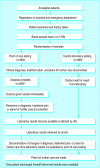Point of care testing: randomised controlled trial of clinical outcome
- PMID: 9552905
- PMCID: PMC28507
- DOI: 10.1136/bmj.316.7137.1052
Point of care testing: randomised controlled trial of clinical outcome
Abstract
Objectives: To describe the proportion of patients attending an accident and emergency department for whom blood analysis at the point of care brought about a change in management; to measure the extent to which point of care testing resulted in differences in clinical outcome for these patients when compared with patients whose samples were tested by the hospital laboratory.
Design: Open, single centre, randomised controlled trial. Blood samples were randomly allocated to point of care testing or testing by the hospital's central laboratory.
Setting: The accident and emergency department of the Bristol Royal Infirmary, a large teaching hospital which cares for an inner city population.
Subjects: Representative sample of patients who attended the department between April 1996 and April 1997 and who required blood tests. Data collection was structured in 8 hour blocks so that all hours of the day and all days of the week were equally represented.
Main outcome measures: The proportion of patients for whom point of care testing brought about a change in treatment in which timing was considered to be critical to clinical outcome. Mortality, the length of stay in hospital, admission rate, the amount of time spent waiting for results of blood tests, the amount of time taken to decide on management plans, and the amount of time patients spent in the department were compared between patients whose samples were tested at the point of care and those whose samples were sent to the laboratory.
Results: Samples were obtained from 1728 patients. Changes in management in which timing was considered to be critical occurred in 59 out of 859 (6.9%, 95% confidence interval 5.3% to 8.8%) patients in the point of care arm of the trial. Decisions were made 74 minutes earlier (68 min to 80 min, P < 0.0001) when point of care testing was used for haematological tests as compared to central laboratory testing, 86 minutes earlier (80 min to 92 min, P < 0.0001) for biochemical tests, and 21 minutes earlier (-3 min to 44 min, P = 0.09) for analyses of arterial blood gases. There were no differences between the groups in the amount of time spent in the department, length of stay in hospital, admission rates, or mortality.
Conclusion: Point of care testing reduced the time taken to make decisions on patient management that were dependent on the results of blood tests. It also brought about faster changes in treatment for which timing was considered to be critical in about 7% of patients. These changes did not affect clinical outcome or the amount of time patients spent in the department.
Figures
Comment in
-
If devolved facilities are used, processes may be streamlined.BMJ. 1998 Sep 19;317(7161):818-9. BMJ. 1998. PMID: 9786686 Free PMC article. No abstract available.
References
-
- Santrach P, Burritt M. Point of care testing. Mayo Clin Proc. 1995;70:493–494. - PubMed
-
- Fleisher M. Point of care testing: does it really improve patient care? Clin Biochem. 1993;26:6–8. - PubMed
-
- Jatlow P. Point of care laboratory testing in the emergency department. Am J Clin Pathol. 1993;100:591. - PubMed
-
- Brown H. Near patient tests are poorly evaluated. BMJ. 1997;314:1785. - PubMed
-
- Sands V, Auerbach P, Birnbaum J, Green M. Evaluation of a portable clinical blood analyser in the emergency department. Acad Emerg Med. 1995;2:172–178. - PubMed
Publication types
MeSH terms
LinkOut - more resources
Full Text Sources
Miscellaneous

